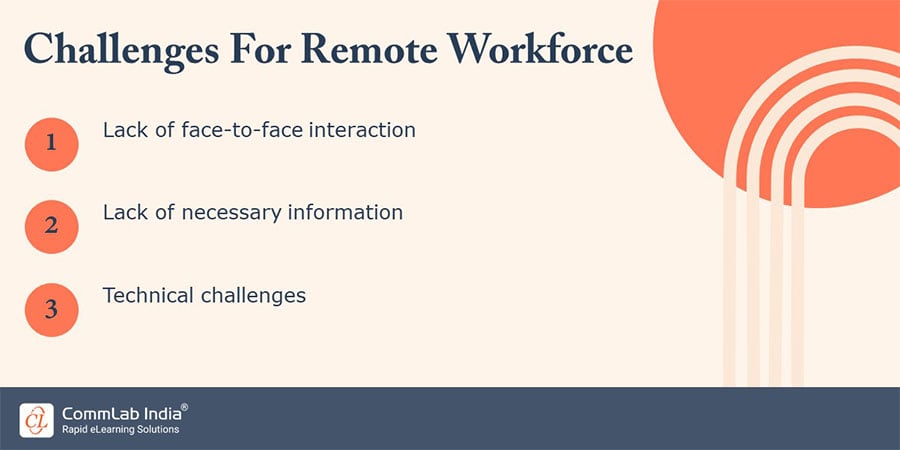Corporate Training For Remote and Seasonal Workforce- An Overview

Many organizations experience a boost in business seasonally, and for some, that means hiring seasonal employees. Sometimes, you also need to hire remote employees to meet the demands of the business. Onboarding new employees and getting them to speed up quickly to meet the demands of the seasonal rush can be a challenge. The solution? Developing corporate training programs that are engaging and deliver result-oriented outcomes for the organization.
Want To Impart Effective Training To Your Remote And Seasonal Workforce?
Follow these best practices to ace the game-
- Impart product-specific and relevant training
- Create engaging and mobile-responsive training
- Maintain the training frequency
- Train with buddies and create a positive learning environment
Challenges Of Corporate Training For Remote And Seasonal Workforce
While it is extremely important for organizations to train their remote and seasonal workforce, the short-term nature of seasonal employment and the lack of being together at one place in remote employment poses some challenges to training. These hires also have a hard time investing in training that may not be relevant once their time at the company is over. Hence, we need to keep all training relevant and meaningful for the employees.
Let’s understand some of the common challenges, you may face when training remote and seasonal workforce.
Seasonal Workforce
The pressing need of seasonal employment can be challenging for the L&D team. Because the prime focus is always on hiring employees at peak business season, training them for the work usually becomes an afterthought. And also because seasonal employees are temporary, organizations don’t realize the importance of training them.
Seasonal employees also think similarly. They also have a hard time investing in training that will only be valid till their time in the organization. Hence, L&D teams need to keep the training relevant and meaningful for employees. Another common challenge is the training timeline- because the employment period is short, organizations need to conduct training that is quick and competent.
→ Download eBook- Blended Learning To Boost Employee Performance
While the seasonal workforce is for a shorter duration, the remote workforce has its own set of challenges in training.
Remote Workforce

Lack Of Face-To-Face Interaction
Many employees consider corporate training as a compulsory check box that needs to be filled and does not pay complete attention to their training. This can particularly create a challenge with a remote workforce where there is no in-person supervision for employees.
Lack of Necessary Information
Remote workers need to know the WHAT, WHEN, WHY, WHERE and HOW of the business to perform to their fullest. Due to their remote existence, they sometimes find it difficult to get access to the relevant information or navigate through the training courses hosted on the Learning Management Systems (LMS) to bridge their skills gap. This impacts their job performance and decreases their productivity, leading to unfavorable results for the organization. When they find it difficult to get answers to even simple questions, it impacts their performance negatively.
Technical Challenges
The remote workforce is dependent on the virtual age of the internet which can sometimes be interrupted by technical issues. Your work may be stuck due to unstable internet and VPN connections, software issues, etc. However, you can take certain precautions to minimize these issues. We will cover this in the later section.
These challenges in corporate training for hybrid workplaces make it important for organizations to organize smooth training for their remote and seasonal workforce. Wondering how to do that?
Tips To Successfully Train Remote And Seasonal Workforce
L&D teams should develop online learning courses to impart knowledge effectively and drive better results. In the virtual environment, you can easily facilitate consistent and relevant training for the remote and seasonal workforce.
Here are 5 tips to successfully train remote and seasonal employees

Focus On Relevant Training
Most of your seasonal workforce may already possess the required skills for the job (that’s why they are hired during peak business hours). So you need to train them on specific things that are required in their job. They don’t need to learn every aspect of your business operations, but just the skills necessary for them. Similarly for a remote workforce, target specific product knowledge and soft skills that will increase their productivity. For example, if you have hired a remote graphic designer during peak business months, train him on some advanced designing software that will help him do better at work.
Create Engaging Content
A temporary workforce sometimes feels that they are not a permanent part of the organization. It is important to create content that engages them and makes them feel a part of the team. They must feel included and valued equally as permanent employees. The same goes for remote employees, their training content should be engaging enough to keep them hooked and not get distracted by other things. Plus, these things also set the understanding that the expectations placed on the remote and seasonal workforce are the same as permanent and on-site employees. Offering interesting microlearning lessons can help them focus better, thereby increasing their knowledge retention.
Watch this video to explore some winning tips to design an effective microlearning program.
Maintain A Training Frequency
You need to facilitate a dedicated training frequency for your remote and seasonal workforce. Instead of overwhelming employees with too much work pressure, it is important to maintain a balance and schedule regular training throughout their work. When creating a timetable, it is important to cover the most critical skills first. Prioritize skills that they will need for the job to ensure maximum productivity. Keep the less important training for later on. Scheduling training at regular intervals results in better management and motivates your employees to work harder.
Training With Buddies
When you join as a remote or seasonal employee- it’s a completely new environment, and how you wish you had a friend here! Enter the concept of ‘work buddies’. Facilitating on-the-job training with a work buddy who can help you understand the organization, its functioning and your work expectations can be an effective way to get started. Pairing remote and seasonal employees with in-house employees can help them learn quickly and also make them feel a part of the team
Make Learning Mobile Friendly
Another way to enhance training for seasonal and remote employees is to offer learning at their fingertips. With the world moving mobile, why should the L&D teams stay behind? When you offer mobile learning to your employees, they can access the training anytime and anywhere at their convenience. This gives a big push to your employees and increases their learning retention.
Offer Positive Reinforcement
A little appreciation can go a long way for your remote and seasonal workforce. It can create a positive work experience for them and helps in increasing their productivity during peak business season.
Summing It Up
Having a remote and seasonal team can be a challenge for organizations if not trained properly. With the right strategies in place, you can ensure consistent and effective training of your remote and seasonal workforce, thereby making them more efficient and productive.
So, if you are looking to train your remote and seasonal workforce with ease, follow a blended learning approach that offers a mix of classroom training and new methods like microlearning, VILT and interactive eLearning programs.
Time now to create the best blended learning strategy for your organization? Download this eBook and accelerate your training process.





